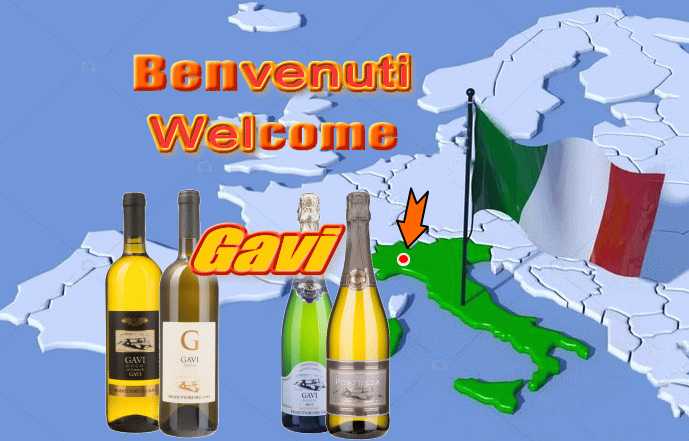
|
| |
|
Prima parte
Seconda parte e altre foto
 |
|
Coloro che giungono a Gavi, anche per
una gita di poche ore, possono visitare monumenti ricchi di storia
millenaria come il Forte, che domina l'abitato, il Portino, la
Chiesa Parrocchiale di San Giacomo, gli oratori e molti edifici e
reperti archeologici che testimoniano la grandezza e lo splendore
che furono di questo antico borgo.
È d'obbligo poi raggiungere il centro della cittadina per visitare i
numerosi negozi e le botteghe artigiane, nonché gustare le
specialità enogastronomiche, come gli amaretti, i ravioli (si dice
siano stati inventati proprio qui) e l'immancabile "Gavi", il famoso
delicato e ottimo vino bianco che della città porta il nome.
E grazie al terreno particolarmente fertile, al clima ideale e
soprattutto alla tenacia dell'uomo, che la vite, da queste parti,
premia le fatiche con raccolti di uve pregiate che, attraverso una
sapiente vinificazione, producono questo vino rinomato anche in
campo internazionale.
La leggenda narra che la principessa Gavia, figlia di Clodomiro re
dei Franchi, sposatasi contro il volere della corte, giunse a Gavi
per sfuggire alle truppe del re. Qui gli sposi vi trovarono acque,
boschi e pace, tanto da decidere di fermarsi. Scoperti, i due, con
il permesso del Papa, poterono stabilirsi ugualmente a Gavi e la
regina dei Goti, Amalasunta, assegnò loro il potere sul territorio.
La principessa era bella e cortese; da qui il nome del vitigno
che da origine al Gavi. Molteplici e interessanti sono le
manifestazioni che si svolgono su tutto il territorio gaviese; tali
proposte hanno il duplice obiettivo di conservare e far conoscere ai
turisti quello che è la cultura, la tradizione, la enogastronomia
del territorio gaviese.
|
|
Those who arrive in Gavi, even for a trip of a few hours, can visit
monuments of thousand-year history as the Fort, which dominates the
town, the Portino, the Parish Church of San Giacomo, local small
churches and many buildings and archaeological finds
witness the grandeur and splendor that were of this ancient village.
You must then reach the center of the town to visit the many shops
and craft shops, as well as enjoy the gastronomic specialties, such
as amaretti, ravioli (said to have been invented here) and the
inevitable "Gavi", the
famous delicate and excellent white wine that the city is named.is (named as
the city)
And thanks to the fertile soil, ideal climate and especially the tenacity of
man, that lives around here, rewards hard work with crops of quality
grapes which, through a careful winemaking produces this wine also
renowned internationally.
A Legend tells that Princess Gavia, daughter of Clodomiro king of
the Franks, who married against the wishes of the court, came to
Gavi to escape the king's troops.
Here the couple found water, forests and peace, and they
decided to stop.
Discovered the two, with the permission of the Pope, could settle in Gavi and
the Queen of the Goths, Amalasunta, gave them authority over the
territory.
The
princess was beautiful and "cortese";
hence the name of the grape variety that originates the Gavi.
Multiple and interesting are the events that take place throughout
the Gavi;
These proposals have the dual objective of preserving and making
known to tourists its culture, the tradition, the gastronomy of the
region Gavi. |
|
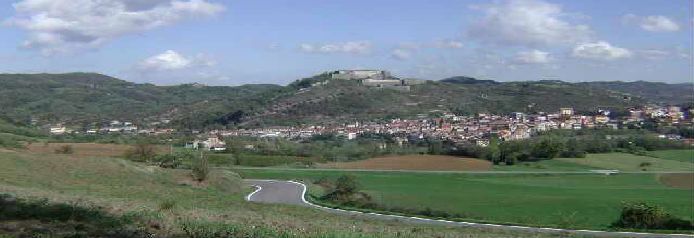
Gavi vista da Sud. |
|
CENNI STORICI
Gavi ha origini molto antiche e piuttosto incerte;
ritrovamenti fanno supporre l'esistenza della stazione neolitica di Cavatium da
cui il latino Gavium.
Le cronache citano l'esistenza di un "castello"
sulla vetta della roccia di Gavi: in esso, la leggenda vuole che trovasse
rifugio dai suoi persecutori la principessa Gavia. Caduto l'impero romano, Gavi
rimase d'ambito bizantino, poi franco. Il ritrovamento di resti di armi arabe
documenta la presenza dei Saraceni (X secolo): da allora la parte est del
monte è denominata appunto Monte Moro.
Notizie storiche certe sul
Castello di Gavi si hanno nel 973. In quel periodo Gavi apparteneva alla
famiglia degli Obertenghi. Da questi discese il ramo marchionale che dal XII
secolo assunse il titolo "di Gavi". Primo marchese di Gavi fu Guido, insediatosi
in loco intorno al 1065, il quale verso il 1116 cedette il marchesato al figlio
Alberto.
Durante il lunghissimo dominio di Alberto (60 anni), Gavi, contornata
da potenze in netto sviluppo quali il vasto comune di Tortona, il Marchesato Aleramico e Genova, e in posizione commercialmente strategica, vide svilupparsi
la sua potenza e diventare pedina ambitissima.Gavi si trovò spesso al centro di
dispute e di alleanze, godendo di un periodo sereno solo durante il dominio
dell'imperatore di Svevia Federico 1, noto come Barbarossa, legato da amicizia
ai marchesi di Gavi ed in possesso di una torre sul Castello in cui soggiornò
più volte.
Alla morte del Barbarossa (1190) le sorti del marchesato di Gavi
andarono sempre più declinando fino a quando il 16 settembre 1202 con atto
ufficiale, passarono ai Genovesi il borgo, il castello e la curia, composta da Tassarolo, Pasturana, Montaldo (Rigoroso), Amelio, Croce e Gottorba, e tutto il
loro territorio oltre Scrivia. Da allora le vicende di Gavi e del suo Forte
furono ,strettamente collegate a quelle della Repubblica di Genova.
|
|
BACKGROUND
Gavi has ancient origins and rather uncertain;
findings suggest the existence of the Neolithic station of Cavatium from which
the Latin Gavium.
The chronicles mention the existence of a "castle" on the top of the
Gavi rock : in it, according to legend, found refuge from his
persecutors Princess Gavia.
When the Roman Empire dropped, Gavi remained of the Byzantine
context, then the franc.
The discovery of the remains of Arab weapons documents the presence of the
Saracens (X century) and since then the eastern part of the mountain
is actually called Monte Moro.
Certain historical reports of Castle Gavi you have in 973. At that
time belonged to the family of Gavi Obertenghi.
From these descended the branch of marquis that in the twelfth
century assumed the title "Gavi".
First Marquis of Gavi was Guido, took office on site around 1065, which gave
way in 1116 to his son the Marquis Alberto.
During the long rule of Alberto (60 years), Gavi, surrounded by
powers in net development such as the large town of Tortona, the
Marquisate Aleramic and Genoa, plus its commercially strategic
location, saw the development of its power and become a wished pawn.
.Gavi
often found itself at the center of disputes and alliances, enjoying
a serene period only during the rule of Emperor Frederick of Swabia
1, known as Barbarossa, connected by friendship to the Marquises of
Gavi and in possession of a tower on the castle where he stayed more
times.
On the death of Barbarossa (1190) the fate of the Marquisate of Gavi
went increasingly declining until September 16-1202, by an official
act, passed to the Genoese the village, the castle and the curia,
included Tassarolo, Pasturana, Montaldo (Rigoroso)
, Amelio, Croce and Gottorba , and all their territory over Scrivia.
Since then the story of Gavi and its Fortress were closely related to those of
the Republic of Genoa. |
|

Gavi vista da ponente |
|
Nel decennio
1348-1358 Gavi ed il suo Castello -torna sotto il dominio della nobile famiglia
dei Visconti. Nel 1359 Gavi ritorna in possesso della Repubblica di Genova
seguendone le vicissitudini, fino a quando, tra alterne vicende, ritorna ai
Visconti. La seconda signoria dei Visconti ha inizio nel 1418, aoi il castello
viene ceduto ai Fregoso e, nel 1468, alla famiglia dei Guasco di Alessandria.
Nel 1528 Gavi e il suo Forte ritornano sotto il dominio della Repubblica di
Genova.
Si apre finalmente un lungo periodo di pace. Nel 1625, Gavi ed il suo
Castello furono interessati dalla guerra tra Genova ed i Franco-Piemontesi. In
tale occasione sostò a Gavi il celebre Cartesio, filosofo e matematico francese
(1596-1650). Verso la metà del '700 la
fortezza di Gavi fu per un breve periodo sotto il dominio austriaco che durante il periodo napoleonico fu teatro di battaglia tra le truppe francesi e
quelle austriache.
Infine, in seguito al trattato stipulato tra Francia, Austria
ed Inghilterra, nel 1814, la repubblica di Genova fu soppressa ed il suo
territorio fu trasferito sotto il dominio del Re di Sardegna Vittorio Emanuele I. |
|
In the decade 1348-1358 Gavi and its castle turn under the
rule of the noble family of the Visconti.
In 1359 Gavi turn back in possession of the Republic of Genoa
following its vicissitudes, until, after ups and downs, turn back to
the Visconti.
The second rule of the Visconti begins in 1418, the castle was sold
to Fregoso and, in 1468 to the family of Guasco of Alexandria.
In 1528 Gavi and its Fort goes back under the rule of the Republic of Genoa.
This
finally opened a long period of peace.
In 1625, Gavi and its castle were involved in the war between Genoa
and the French-Piedmontese.
On
that occasion stayed in Gavi the famous Renè Descartes, French
philosopher and mathematician (1596-1650).
Towards the middle of the '700 the fortress of Gavi was briefly under Austrian
rule; during the Napoleonic period was the scene of battle between
the French and the Austrians.
Finally, following the treaty between France, Austria and England,
in 1814, the republic of Genoa was abolished and its territory was
transferred under the rule of the King of Sardinia Vittorio Emanuele
I.
Seconda parte e altre foto
 |
|
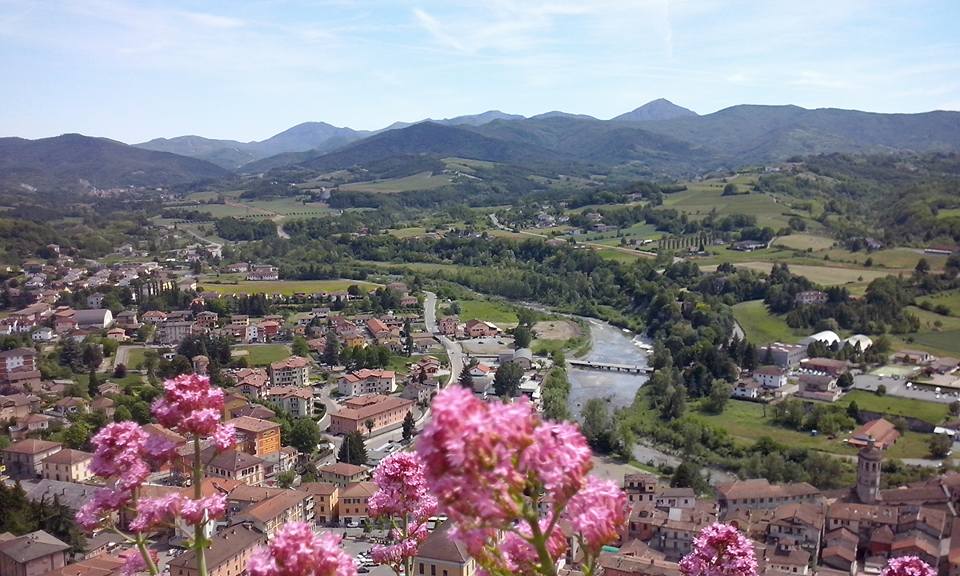
Gavi dal Forte. |
|
IL FORTE DI GAVI
Data la posizione strategica si suppone l'esistenza di una roccaforte fin dal
periodo preromano o più sicuramente romano. Nel periodo medioevale il Forte si
presentava come un castello ornato da due torri a pianta trapezoidale e con alte
mura che lo rendevano inviolabile dai mezzi di guerra dell'epoca.
Quando,
nell'assedio del 1625, l'esercito francese e savoiardo impiegò per la prima
volta l'artiglieria si comprese che la struttura del Forte non era più adeguata.
I rettori della Repubblica di Genova si convinsero della necessità di
irrobustire il castello e per far questo fu incaricato uno dei più grandi
esperti di costruzioni militari, il Fiorenzuola.
I lavori iniziarono nel 1626 e
durarono 4 anni trasformando il castello nell'attuale possente fortezza.
La
Fortezza poteva ospitare una guarnigione che poteva raggiungere i 1000 uomini.
L'ultima battaglia di cui fu teatro il Forte è del periodo
napoleonico, quando fu l'unico caposaldo francese in Italia a non capitolare
agli austro-russi prima della vittoria di Napoleone a Marengo, il 14 giugno
1800.
Nella seconda metà dell'800 la fortezza fu disarmata (decreto del 12 novembre
1854) e divenne reclusorio penale, rimanendo tale fino al 1907.
Durante le due guerre mondiali fu utilizzata come campo di prigionia.
Il Forte di Gavi è, oggi, affidato alla Soprintendenza dei Beni Ambientali e
Architettonici del Piemonte che ne ha curato i numerosi restauri e che continua
nella sua opera di ricerca e di recupero. |
|
FORT of GAVI
Given the strategic location it is assumed that there is a
stronghold since pre-Roman times or more definitely Roman.
In medieval times the fort was presented as a castle adorned by two
trapezoidal towers and by high walls that made inviolable by means
of war era.
When, in the siege of 1625, the French army and Savoy took the
artillery for the first time it was realized that the structure of
the Fort was no longer adequate.
The rectors of the Republic of Genoa were convinced of the need to fortify the
castle and to do this was charged one of the greatest experts in
military buildings, the Fiorenzuola.
Work began in 1626 and lasted four years transforming the castle in the
current mighty fortress.
The fortress could accommodate a garrison which could reach 1000 men.
The last battle which was the scene of the Fort is the Napoleonic period, when
it was the only French stronghold in Italy not to capitulate to the
Austro-Russians first of Napoleon's victory at Marengo, June 14,
1800.
In the second half of the 800 the fortress was disarmed (Decree of 12 November
1854) and became a criminal jail, and remained so until 1907.
During the two World Wars was used as a prison camp.
The Forte di Gavi is today entrusted to the Department of
Environmental and Architectural Heritage of Piedmont who oversaw
numerous restorations and continues the task of search and recovery. |
|
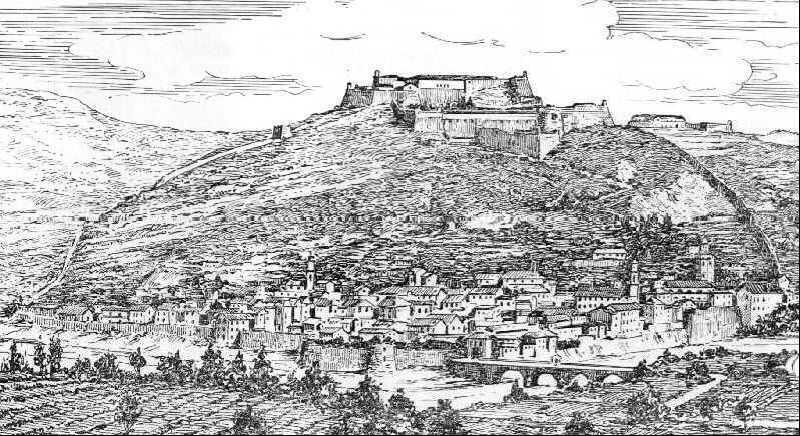
Vecchia stampa di Gavi: Si noti le mura ai lati del
Forte che scendono a chiudere la città.
 Videos Videos
 Gavi: Pressentaz/Storia/Leggenda - Capitale dei Lemurini - Il
Forte - Il Cortese - Di Gavi in Gavi
Gavi: Pressentaz/Storia/Leggenda - Capitale dei Lemurini - Il
Forte - Il Cortese - Di Gavi in Gavi
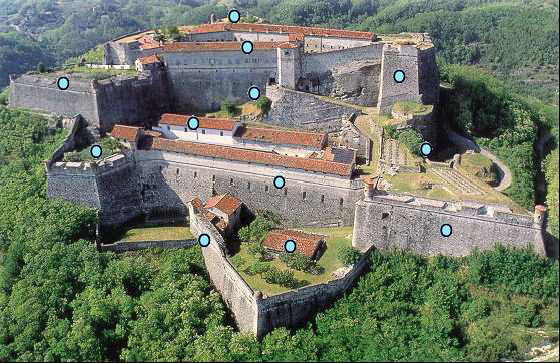
Cliccate i links della foto per aprire e vedere
all'interno del forte.
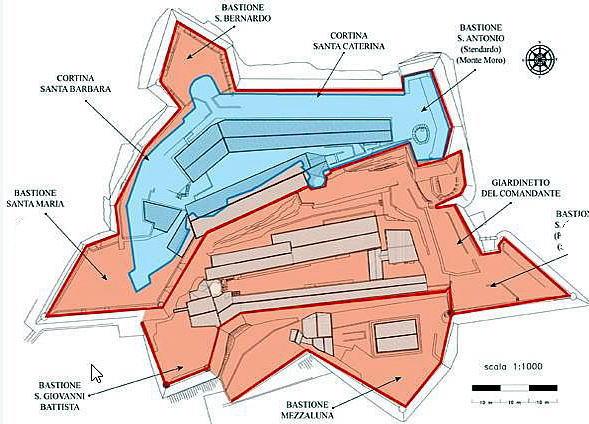
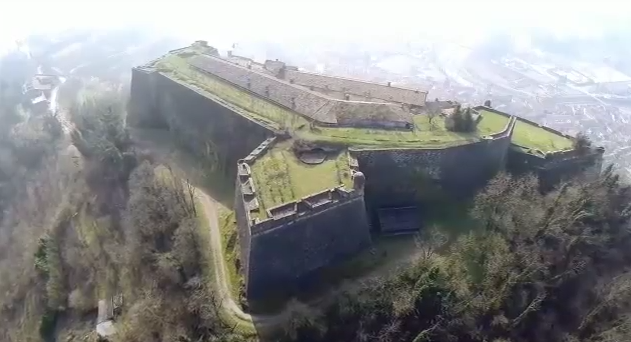
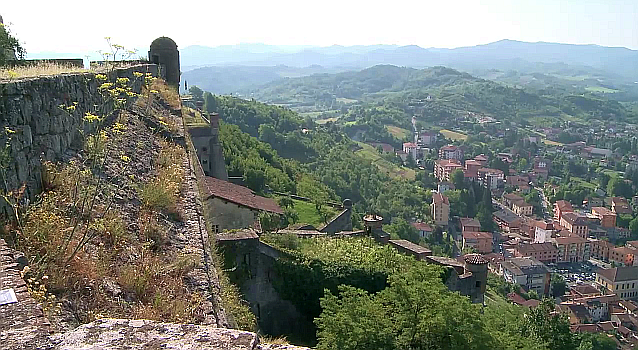
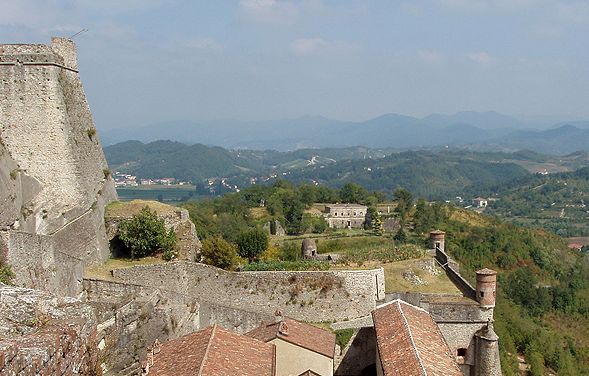 |
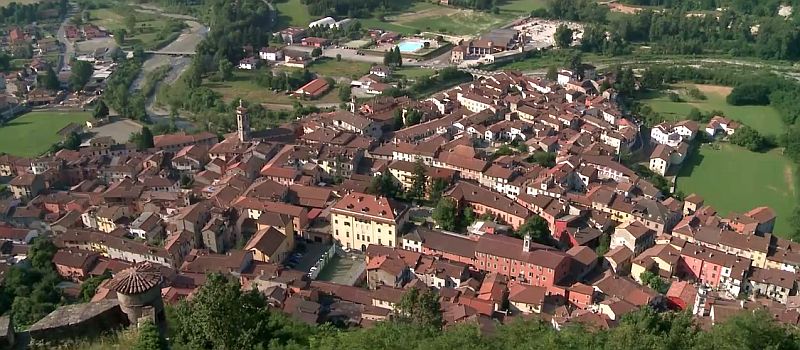
Dal Forte: A sinistra il Campo Sportivo, sullo sfondo la Piscina
Comunale e i capannoni della Bocciofila.
Seconda parte
e altre foto
 |
.jpg)
Gavi ai piedi del Forte. |
|
.jpg)
Periferia Ovest |
Orario
visite al Forte:
Dalle ore 9,30 visite guidate ogni ora fino
all'ultima alle ore 15,30; chiuso il lunedì (eccetto quello di
Pasqua e la settimana della cultura), Natale e Capodanno.
Per i
gruppi è necessaria la prenotazione da effettuarsi via telefonica.
Per visite singole non occorre la prenotazione.
La visita è sempre guidata da personale specializzato del Forte.
Tel. 0143-642679
Prezzo del biglietto di entrata:
Al di sotto
dei 18 anni e sopra i 65 i visitatori non pagano
Scolaresche
ingresso gratuito
Biglietto 18 - 25 anni: 1 euro
Biglietto
intero: 2 euro
Ridotti: insegnanti senza scolaresca, personale
dello stato, studenti universitari in materia di Beni architettonici
e culturali.
Dettagliate informazioni sugli orari al seguente
link:
http://www.fortedigavi.it/fdg/wp-content/uploads/2015/04/Forte_Orari_2017_aggiornati2.pdf
|
Visiting hours of the Fort:
From 9,30 guided tours
every hour until the last
at 15.30; closed on
Mondays
(Open the Monday of Easter, Christmas, New Year
and "The week
of culture").
Groups Reservations are
required to be made
by telephone.
For individual
visits do not need
a reservation.
The visits are guided
by skilled staff of the
Fort.
Tel. 0143-642679
Ticket price of entry:
Under 18 and
over 65 visitors
do not pay
School groups free
admission
Ticket 18 to 25
years: 1
€
Full price: 2
€
Reduced ticket price:
teachers without
pupils, State staff
, college students of Architecture.
Fine della Prima parte |
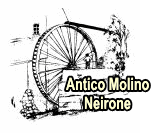 |
|
Seconda parte e altre foto
 |
|

.jpg)
.jpg)














.gif)